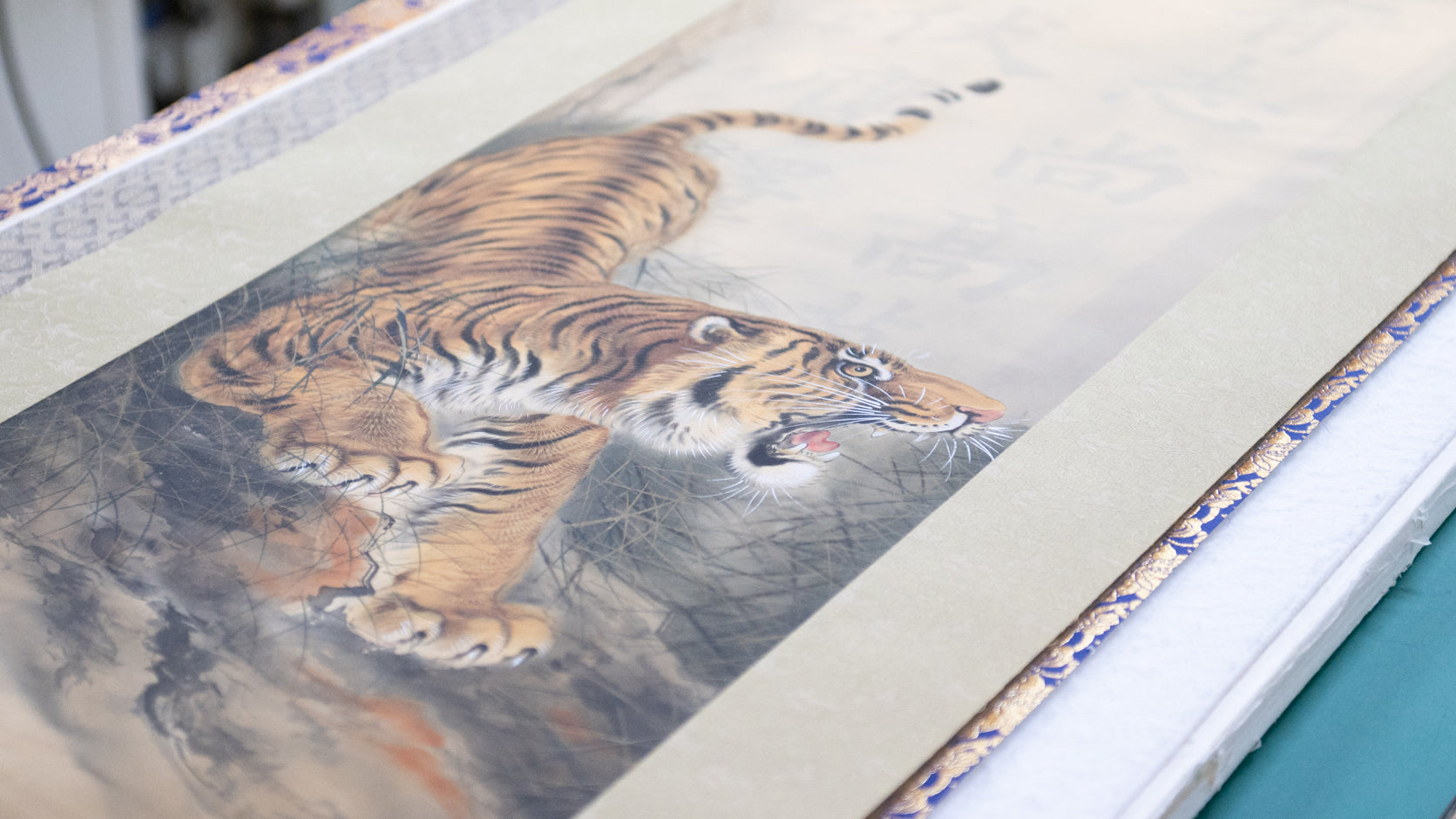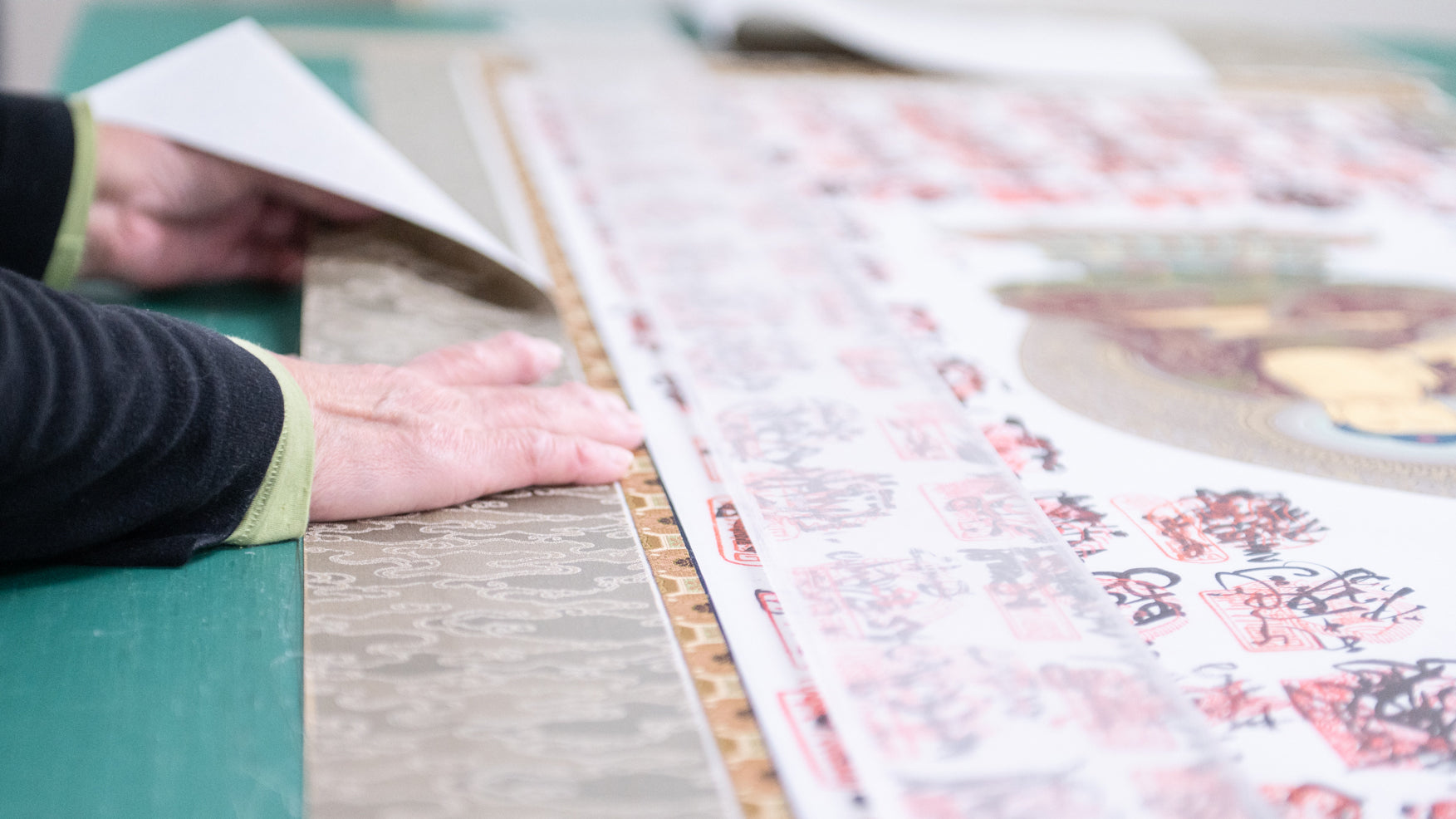Kaikakudo Art was established in Gifu, an area famous for its Mino washi "Japanese paper" culture, and its workshop is exclusively staffed by professionals holding the National 1st. Grade Paper Hanging Specialists qualification. It is rare to find a company even in Japan that handles the entire process of planning, creating, framing, and selling hanging scrolls.

Visiting Kaitakudo Art Vol.1 The workshop space
The Miyabi team visited a workshop in Gifu in the early spring of 2024. Our guide was RIN from the sales department of Kaitakudo Art. RIN Chusei greeted us with a warm smile and guided us through the workshop, shaRINg about himself and the allure of hanging scrolls. In this blog, we will introduce Kaitakudo Art and its workshop in three parts.
The Relationship Between Kaitakudo Art and Gifu Prefecture
Gifu Prefecture, where the workshop is located, is home to a concentration of enterprises and artists specializing in hanging scrolls. I asked RIN Chusei about the reason for this.
"Gifu Prefecture is also known as a famous region for delicious sake, and this is because the water in Gifu has very low iron content. In fact, our company's president, Okazaki, saw a report from a survey conducted by the prefecture a few years ago, which revealed that the water is clean. Low iron content means that rust and stains are less likely to occur. This is one of the conditions that contribute to the beautiful finish of hanging scrolls."
It’s interesting how, similarly, the purity of water affects the finish of hanging scrolls.
The Workshop Scene (2F)
After arriving at Kaitakudo Art, we were immediately guided through the workshop.
The workshop is divided into two floors, both of which are dedicated to the mounting and repairing of hanging scrolls. The difference lies in whether the work is done by hand or with the use of machines.
We were first guided through the second floor. Here, the characteristic feature is that the mounting and repairing of hanging scrolls are done by hand. Perhaps due to the absence of machines, compared to the first floor, it feels more spacious, with windows on both sides, and I imagine that on sunny days, a lot of sunlight would come in. Unfortunately, it was raining on the day of our visit, making the interior feel rather cold.
The space was filled with long tables Lined up, with about two people working at each table. Looking around, hanging scrolls were propped up against the walls on boards after being worked on. A common sight at each table was craftsmen working silently and earnestly at their respective stations, with the atmosphere so tense that we hesitated to even speak to them.
The tables were arranged in order of the mounting steps, and RIN Chusei explained how the work is being done.
Step 1: Color Matching
The term "fabric" refers to the cloth used in the mounting of hanging scrolls.
When orders for the repair or creation of hanging scrolls come in, the mounting craftsmen utilize their exceptional sense of style to select the fabric that best suits the artwork.
There are various types of fabric, differing in material, pattern, and color. Choosing a fabric that matches the theme or design of the hanging scroll can significantly enhance the overall atmosphere and impression of the work.
We were shown the process starting from Step 2.
Step 2: First Backing (honshi “main work” Backing)
One person carefully peels off the old honshi using small scissors, ensuring not to damage it.The key here is to remove even the dust attached to the honshi cleanly.
This task is more efficient on sunny days because the dust and debris attached to the honshi are easier to remove under natural light. This explains why the workshop has many windows.
Then, washi is applied to the back of the artwork.
Another person uses a brush and glue to work carefully and quickly, ensuring no air gets trapped between the artwork and the washi.
Watching up close, the speed and skill with which they moved the brush were impressive.
There was also a craftsman who used the brush to make tapping sounds while working. This is to remove air bubbles. Without this step, air bubbles could form, leading to unevenness in the hanging scroll.
The finish is affected by the season, so proper temperature and room humidity control are necessary.
This is especially essential for the glue used in the backing process. The composition of the glue varies between summer and winter; in summer, due to the higher temperatures, it is formulated with a lower salt content.
The first thing the craftsmen do in the morning when they arrive is to mix the glue. The consistency of the glue is considered each time, depending on how it turns out. If the glue is too thick, the mounting becomes hard and may crack. If it's too thin, it becomes soft and may peel off. The thickness of the glue also needs to be considered depending on the type of fabric and paper.
Step 3 Temporary Pasting
Temporary pasting involves affixing the work that has been backed onto a board and then drying it in a drying room. The drying room is located at the back of the room, where the backed items are air-dried and propped against the wall. Humidity and other conditions are then adjusted using air conditioning. The process takes about a day to dry, and in the morning, the craftsman takes it out to proceed to the next step.
I would like to conclude this part here. In the next chapter, I will introduce the process leading up to the completion of the hanging scroll.
Related Blogs
Values and Culture
Our employee culture is as vibrant and diverse as the fashion industry itself. We foster a creative and collaborative environment where ideas are encouraged to flourish.
Sustainable Material
We believe in the power of sustainable fashion. That's why we carefully select eco-friendly materials to produce our clothing line. From organic cotton to recycled polyester, we are committed to reducing our environmental impact.
Giving Back
We believe in paying it forward. Our team engages in charitable efforts and volunteers their time to make a positive impact on our local community.





